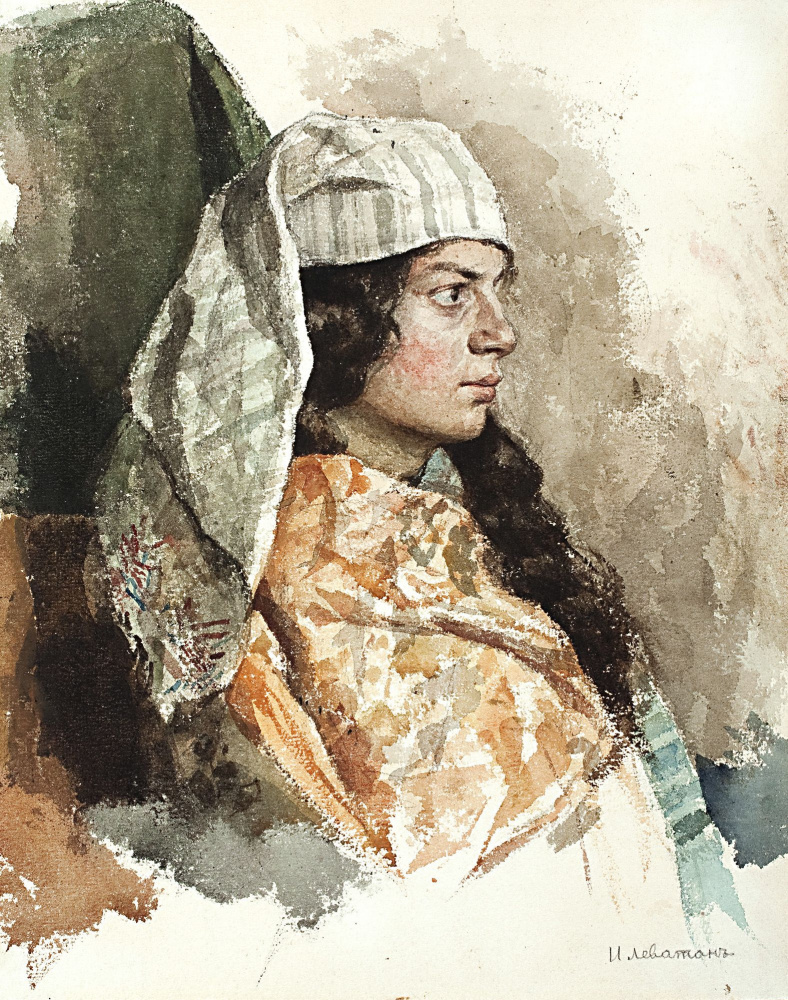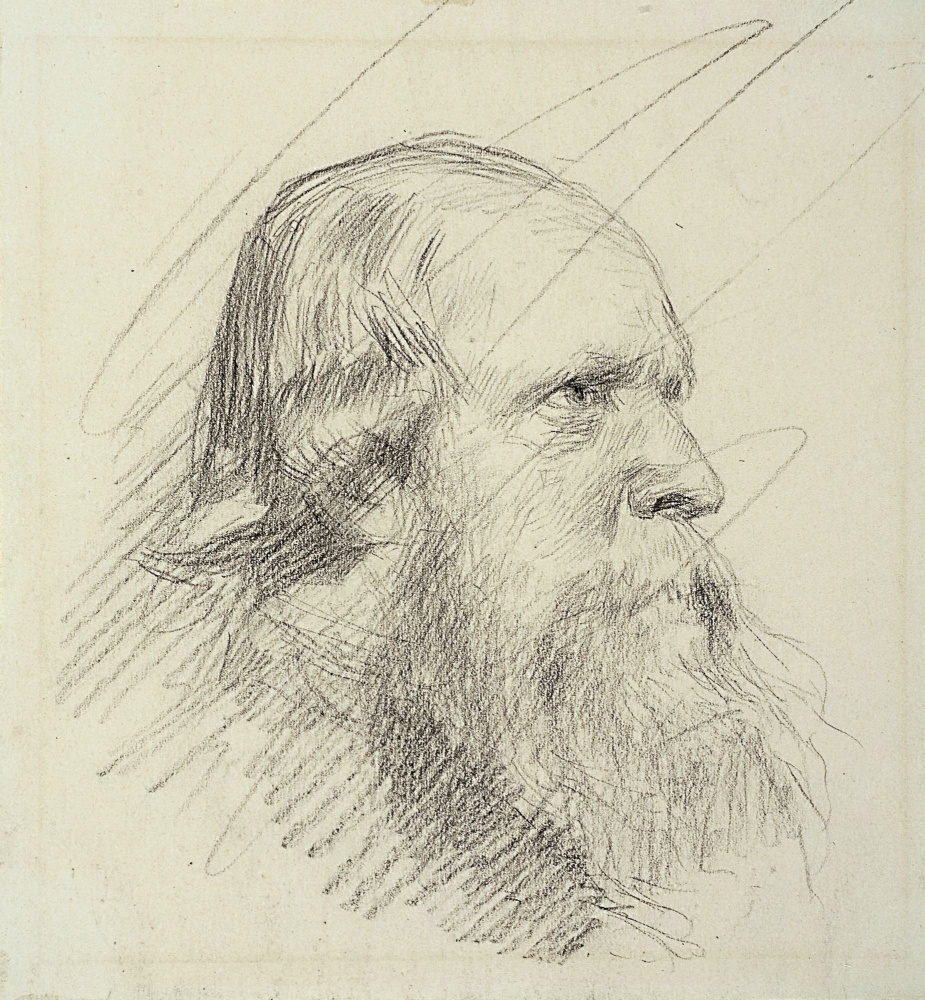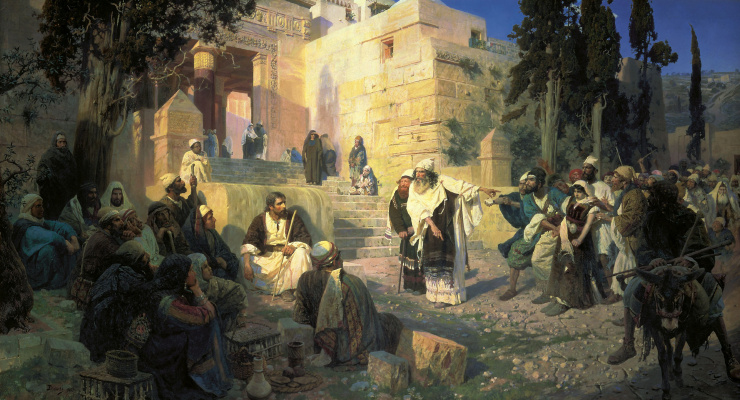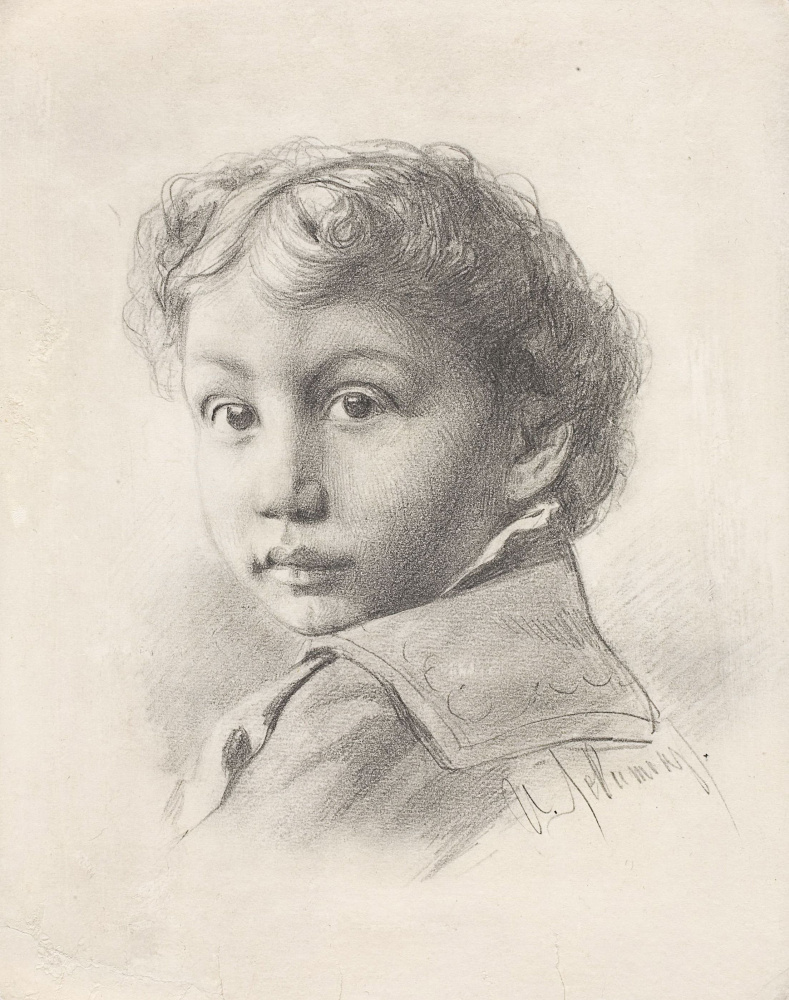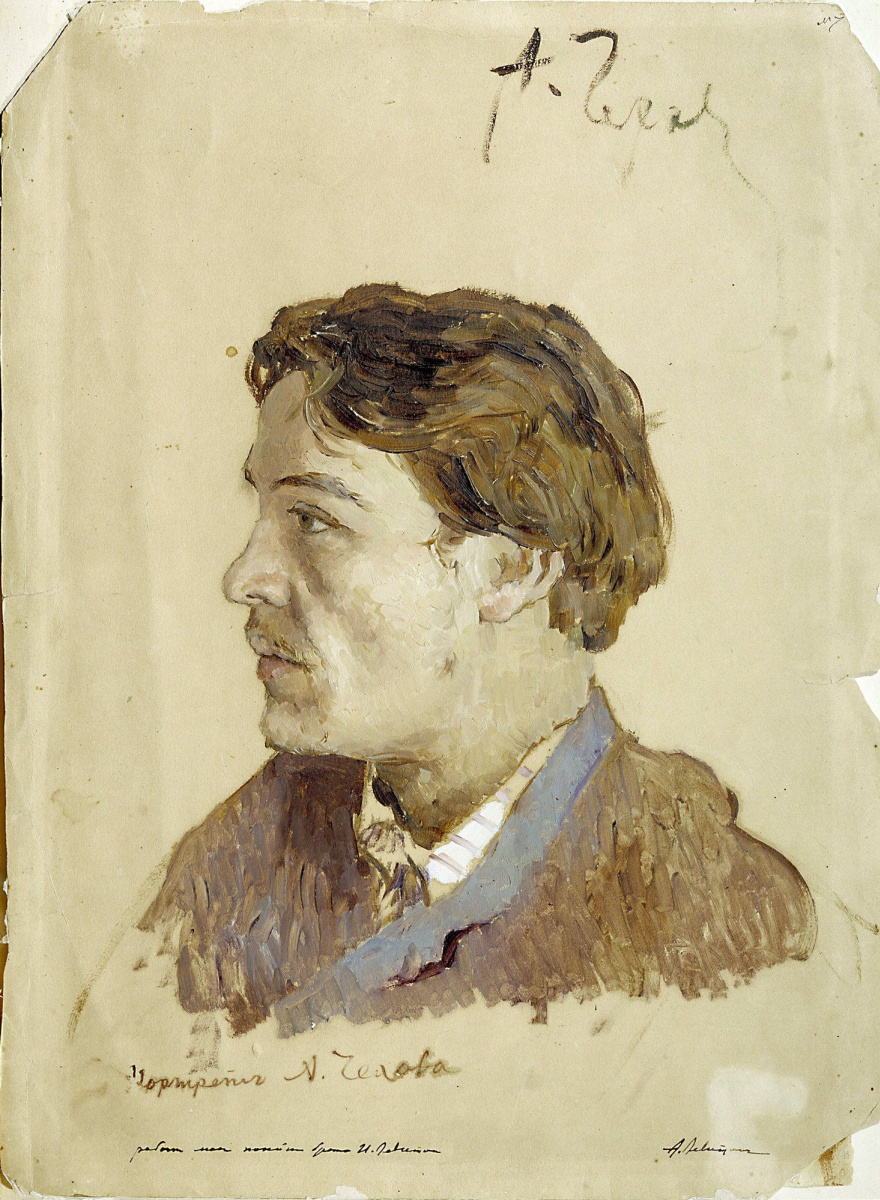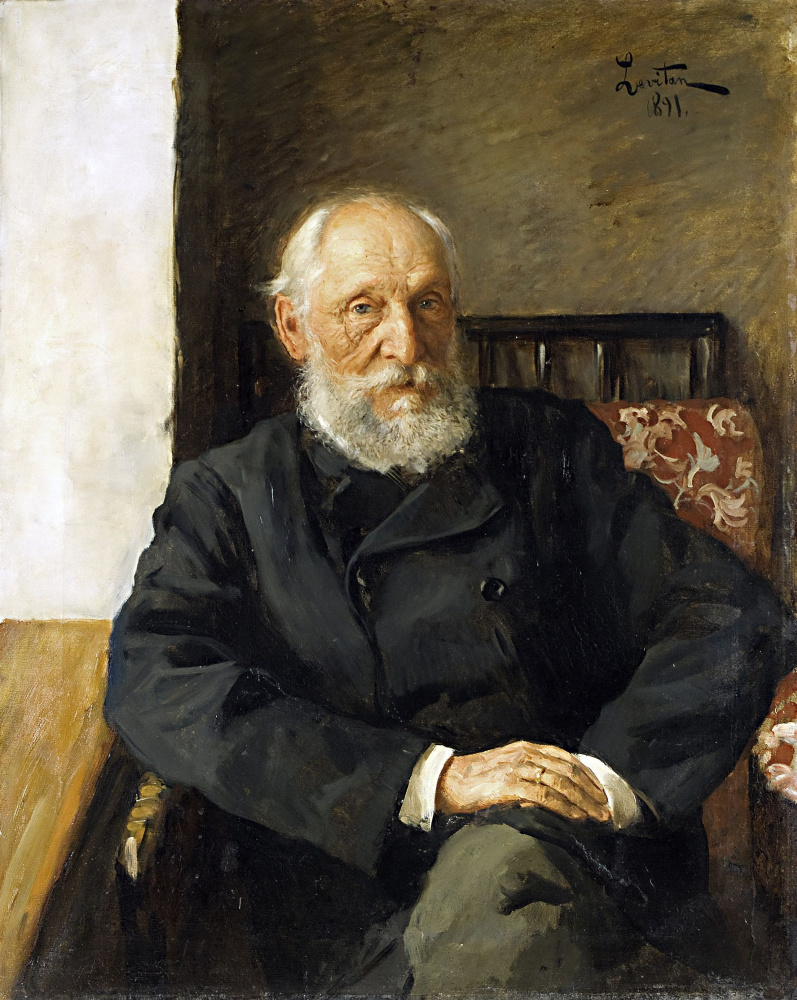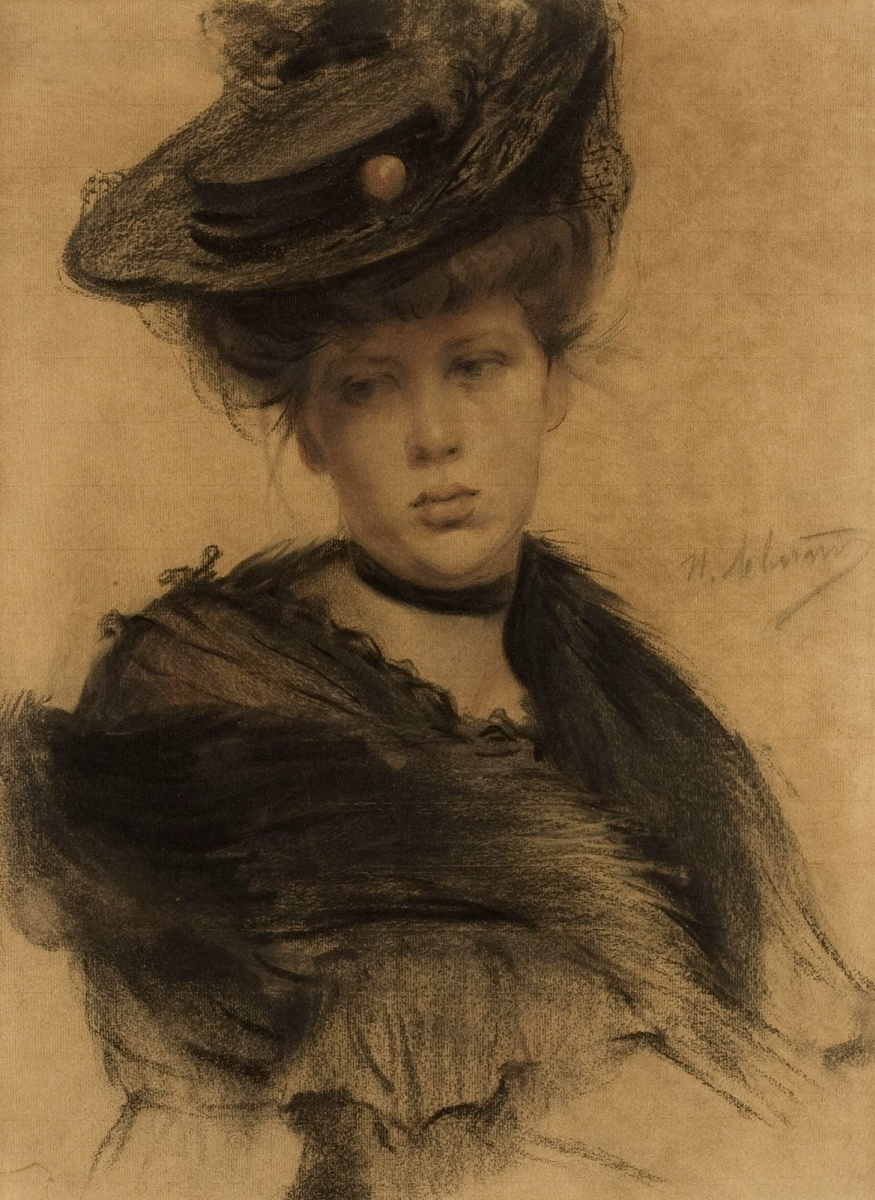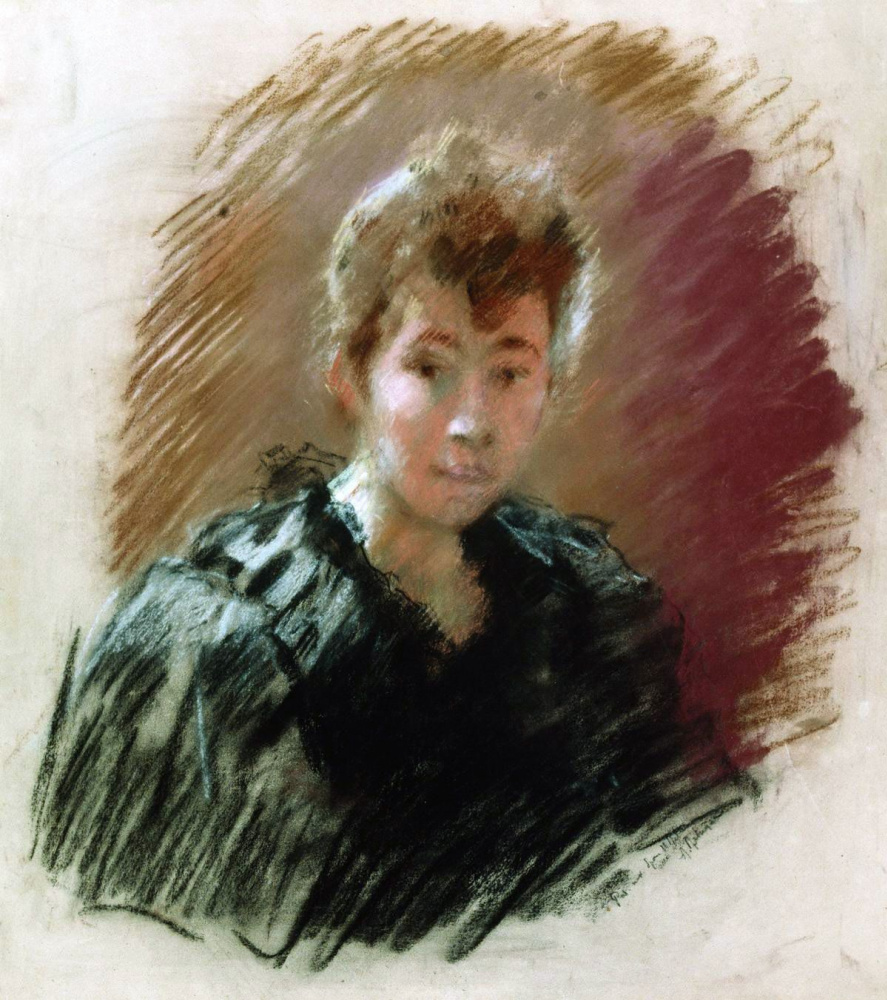There is a steady delusion that Isaac Levitan did not know how to write people. Arthiv proposes to find out if it really is, who were the people who were lucky enough to be captured by the great landscape painter, and what exactly connected them with Levitan.
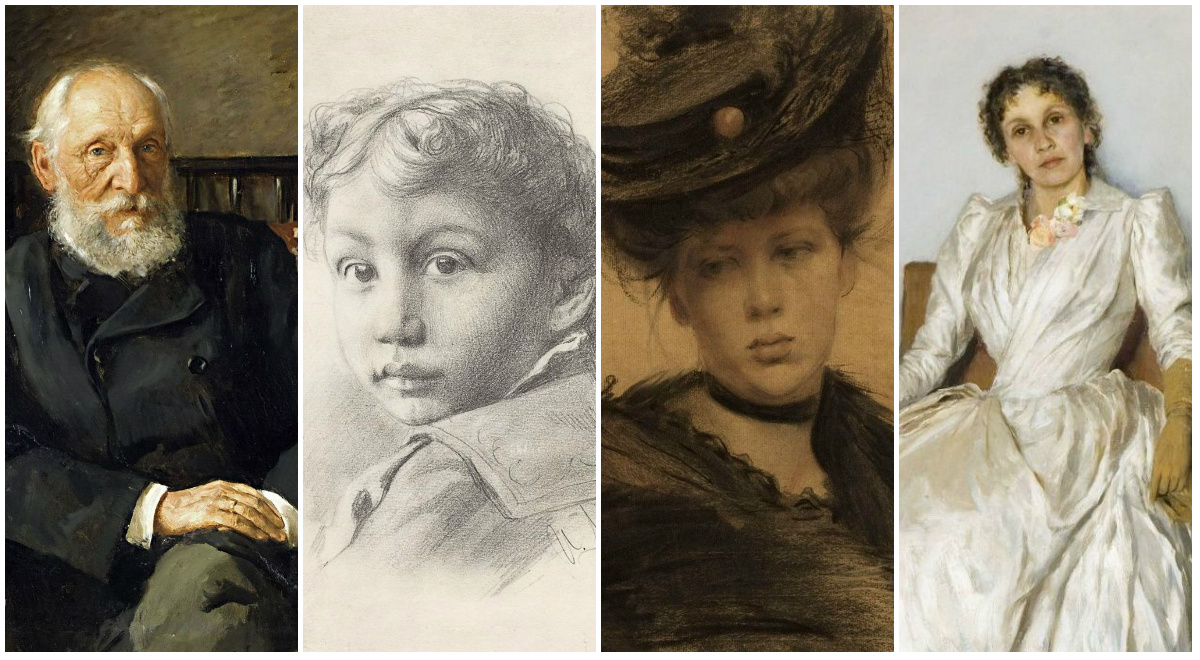
It is easy to understand the basis of the statement that human faces and figures were not given to Levitan. Firstly, all the portraits ever made by Levitan can be counted almost on the fingers (there are in fact a little more than ten) - whereas landscapes go for hundreds or even thousands if you consider etudes. Secondly, the story is widely known that when it took to inscribe a female figure in the Levitan landscape “Autumn day. Sokolniki, I had to ask Nikolai Chekhov, a fellow student of the artist and the writer's brother, to do this favor. Thirdly, viewers are accustomed to perceive Levitan as a pure landscape painter, self-sufficient and absolute - besides the landscape painter, who in principle avoids embedding a person in the natural landscape. "Landscape creativity has overshadowed all his experiences in other genres and types of creative activity, - Nina Markova writes in the article “Non-landscape Levitan”. - Who remembers now that the painter was engaged in magazine graphics and book illustration, wrote theatrical scenery, created portraits and still lifes? ”
Self-portrait
1885, 37.7×27.8 cm
"I want to write a haystack, there are no bones and anatomy in it ..."
And yet, can an artist who has received a thorough education - and Levitan, as we know, spent eleven years at the Moscow School of Painting, Sculpture and Architecture - never write human heads and torsos “from gypsum”, not understand to portray from life?
Artist Zakhar Pichugin, Levitan's friend MUZHVZ, recalled: “Upon graduation and leaving the School, in order to receive a medal, it was necessary to write an etude from a naked model, which he coped with very successfullybut". Apparently, a friend of Levitan also talks about this case. Mikhail Nesterov: “Somehow he came to us in a natural class and wrote an optional sketch for a landscape painter of a naked body, wrote in his own way, in two or three days, although it was a month to rely on.
The etude impressed by Pichugin and Nesterov is unfortunately unknown - the fate of some portrait works by Levitan, whose references are found in memoirs and archival documents, is also vague and uncertain. Researchers suggest that some of the portraits may be stored in private collections in the form of family relics, others may show up somewhere in the archives as works of an unknown master. So, quite possibly, the portrait Levitan will still present surprises to painting connoisseurs in the future.
As for the anatomy and the technical side of the human image in general, the attitude of Levitan will be more accurate to describe in words “Knew how, but not loved”. His classmate Savrasov workshop - artist Konstantin Korovin- remembers how they, together with Levitan, prepared for exams. Isaac enthusiastically crammed the geography of Egypt, Kostenka (this was the name of the cheerful and kindly Korovin who knew him) insisted that it was time to move from geography to anatomy.
"- No, wait, - I say, - Let's better anatomy ...
- Well, why is that? I will never write a person. Anatomy! I don't want to know what my bones are, what kind of lens in my eye. Oh, that's impossible ...
- No, I must know - I say with intent. - Today you wanted to write in the evening "Galki fly ..."
- So what?..
- So - must know the anatomy of the jackdaw ...
Levitan stared at me and said, burning:
- But there is no anatomy of spring ...
- It seems not yet, but will ...
- Well, enough. You're a crocodile! I can't, I don't want to know a person, why do I need his bones?
- And the Italians knew the anatomy, Michelangelo knew, - I say ...
- Yes, yes, true, but I want to write a stack of hay, there are no bones and anatomy in it ... "
On the anatomy exam, according to Korovin, Levitan curiously refused to take the human skull, the structure of which he was to describe to the examiners, only repeated "It's horrible! This is death! I cannot see the dead, the dead ... "
Brothers Sergei and Konstantin Korovin, laughing, began to tease Hamlet Levitan - it was too good, they say, the melancholic manages the scene with a skull ...
Lithographs Levitan in the journal "Moscow", 1882.
In journalism, which Levitan had to perform, this disregard of anatomy was noticeable: the figures of the peasants are sketchy, the angles are not without errors, and the movements are constrained and conditional. Levitan not only did not tolerate, but did not know how to work in genre and satirical painting, all of his nature rebelled against this: his brush seemed to become clumsy, and he himself was surprisingly tongue-tied. Everything that was done not for the sake of art, but for the sake of earnings, came out exhausted and awkward.
But if Levitan happened to be ignited by some artistic idea or found himself in an atmosphere where art was put at the forefront, a wonderful transformation took place - people in his portraits began to live and breathe.
In journalism, which Levitan had to perform, this disregard of anatomy was noticeable: the figures of the peasants are sketchy, the angles are not without errors, and the movements are constrained and conditional. Levitan not only did not tolerate, but did not know how to work in genre and satirical painting, all of his nature rebelled against this: his brush seemed to become clumsy, and he himself was surprisingly tongue-tied. Everything that was done not for the sake of art, but for the sake of earnings, came out exhausted and awkward.
But if Levitan happened to be ignited by some artistic idea or found himself in an atmosphere where art was put at the forefront, a wonderful transformation took place - people in his portraits began to live and breathe.
Jewish woman in the eastern bedspread
A Jew in the Eastern veil
1884, 39×26 cm
The expressive watercolor etude “The Jewish Woman in the Oriental Cover” is kept in the memorial historical-artistic and natural museum-reserve of V.D.Polenov in the Tula Region. Why is the study of Levitan found in the museum Polenova?
The explanation is very simple. Landscape class teacher MUZHVZ Vasily Polenovreplacing this post Alexey Savrasov, liked to collect talented students on "drawing Thursdays" and "watercolor sunday mornings" in his estate.
Vasily Dmitrievich's sister Elena Polenova, and the interesting artist herself, told in a letter to a friend: “... today at our Sunday meeting there were two new members: Vasilyin's students Levitan and Korovin ... Levitan made a watercolor — a pink head — lovely what it is!” And about another case: “After the tea, an old man’s head was drawn with a pencil, very interestingly lit and characteristic ... What did Levitan do! Well, just a delight! .. "
The explanation is very simple. Landscape class teacher MUZHVZ Vasily Polenovreplacing this post Alexey Savrasov, liked to collect talented students on "drawing Thursdays" and "watercolor sunday mornings" in his estate.
Vasily Dmitrievich's sister Elena Polenova, and the interesting artist herself, told in a letter to a friend: “... today at our Sunday meeting there were two new members: Vasilyin's students Levitan and Korovin ... Levitan made a watercolor — a pink head — lovely what it is!” And about another case: “After the tea, an old man’s head was drawn with a pencil, very interestingly lit and characteristic ... What did Levitan do! Well, just a delight! .. "
Alter Mann mit Bart
1888, 15×14 cm
Who exactly became the model for the "Jewish women in the eastern veil", now it is difficult to say. But we can safely assume for what picture the owner of the “watercolor mornings” could use these ideas. Apparently, the same model, which Levitan painted with such watercolor, could serve as a model for a Jewish woman caught in adultery, in the large-scale canvas Polenova “Christ and the Sinner”. Interestingly, Vasily Polenov tried to write Christ for this and other pictures of the Gospel cycle both from Levitan and from Korovin, but he stopped because of greater reliability, of course, on Levitan.
By the way, it is a mistake to assume that Levitan himself, unlike Polenov with his “Christ and a sinner”, did not write multi-figure compositions in his life: his work was presented at the Israel Museum in Jerusalem "On the way to Zion", made by the artist in 1890, commissioned by the Society for the Enlightenment of Jews in Russia.
Portraits of girls from the Yakovlev family
Two children's portraits, made by a 20-year-old Levitan, have more memorial than artistic value, but they can indirectly tell a lot about homeless youth and the history of the formation of Levitan.
19-year-old student received 100 rubles from Pavel Tretyakovfor the painting “Autumn Day. Sokolniki ”, Levitan was triumphant: this amount promised him, as well as his sister’s family Theresa, patronized by the artist, a certain number of full days. But the money quickly ran out. "Levitan was looking for earnings and did not refuse any orders, - Says the biographer of the artist Sofia Prorokov. - They will ask to make a drawing with gravestones, he goes to the cemetery, draws. Fulfills an order with all the diligence and skill, on what is capable. The customer likes ... All these works were paid scanty. He also wrote copies of paintings in the Tretyakov Gallery, wrote portraits in which he was not very strong ... ”
Fortunately, the name of the novice artist after the purchase of his paintings by the Tretyakov became well known in the circles of art lovers. And in 1880, titular adviser Vasily Vasilyevich Yakovlev, not indifferent to art, invites a talented young man to give painting lessons to his nine-year-old stepdaughter Lena Nenarokova. "He came, trying to maintain solidity, - reconstructs the situation of Sofia Prorokov, - but adolescence peeped in his shyness, in frank inexperience. At the request of parents Levitan painted portraits of the student and her sister. Together with Lena's father, he visited their estate in winter, skied there on the snowy banks of the Dnieper and made sketches of landscapes shrouded in winter clothes.
The matured Lena Nenarokova, in marriage Elena Fedorovna Deysha, will leave curious memories of her teacher. She, among other things, told how she and her stepfather visited Levitan's workshop and there she especially remembered the portrait standing on the easel "Some pale old woman"Levitan, obviously, to order, wrote from a photographic card. It is possible that sometime this work will be sensationally found.
"My mother teased him portraits, - recalls Elena Nenarokova-Deysha, - my and my sister. He drew a pencil on yellowish-pink paper. Portrait of his sister, he soon succeeded, and with my had to tinker. He made two copies, and he was not satisfied. ”.
Little Nadia Yakovleva, whom Levitan, for lack of experience in portraying, portrayed somewhat constrained and clumsy, with his hands folded on his knees and his mouth parted from the strain, will not become just a couple of years - she will drown in the Dnieper on July 26, 1882. Levitan will experience this tragedy together with the family of Yakovlevs who greeted him, and even specially go with her parents to Larino to make a sketch of her grave for them.
Now the portrait of Lena, transmitted by her heirs, is kept in the Tretyakov Gallery, and Nadin - in the Russian Museum.
19-year-old student received 100 rubles from Pavel Tretyakovfor the painting “Autumn Day. Sokolniki ”, Levitan was triumphant: this amount promised him, as well as his sister’s family Theresa, patronized by the artist, a certain number of full days. But the money quickly ran out. "Levitan was looking for earnings and did not refuse any orders, - Says the biographer of the artist Sofia Prorokov. - They will ask to make a drawing with gravestones, he goes to the cemetery, draws. Fulfills an order with all the diligence and skill, on what is capable. The customer likes ... All these works were paid scanty. He also wrote copies of paintings in the Tretyakov Gallery, wrote portraits in which he was not very strong ... ”
Fortunately, the name of the novice artist after the purchase of his paintings by the Tretyakov became well known in the circles of art lovers. And in 1880, titular adviser Vasily Vasilyevich Yakovlev, not indifferent to art, invites a talented young man to give painting lessons to his nine-year-old stepdaughter Lena Nenarokova. "He came, trying to maintain solidity, - reconstructs the situation of Sofia Prorokov, - but adolescence peeped in his shyness, in frank inexperience. At the request of parents Levitan painted portraits of the student and her sister. Together with Lena's father, he visited their estate in winter, skied there on the snowy banks of the Dnieper and made sketches of landscapes shrouded in winter clothes.
The matured Lena Nenarokova, in marriage Elena Fedorovna Deysha, will leave curious memories of her teacher. She, among other things, told how she and her stepfather visited Levitan's workshop and there she especially remembered the portrait standing on the easel "Some pale old woman"Levitan, obviously, to order, wrote from a photographic card. It is possible that sometime this work will be sensationally found.
"My mother teased him portraits, - recalls Elena Nenarokova-Deysha, - my and my sister. He drew a pencil on yellowish-pink paper. Portrait of his sister, he soon succeeded, and with my had to tinker. He made two copies, and he was not satisfied. ”.
Little Nadia Yakovleva, whom Levitan, for lack of experience in portraying, portrayed somewhat constrained and clumsy, with his hands folded on his knees and his mouth parted from the strain, will not become just a couple of years - she will drown in the Dnieper on July 26, 1882. Levitan will experience this tragedy together with the family of Yakovlevs who greeted him, and even specially go with her parents to Larino to make a sketch of her grave for them.
Now the portrait of Lena, transmitted by her heirs, is kept in the Tretyakov Gallery, and Nadin - in the Russian Museum.
Portrait of a boy, Joseph Levin
Porträt eines Jungen, Joseph Levin
1880-er
, 21×17 cm
Relatively recently, in 1993, the Tretyakov Gallery acquired another children's graphic portrait of Levitan, probably not much later than portraits of girls from the Yakovlev family, in the early 1880s, but showing a noticeably increased level of skill of the young artist in the transfer of character to the model.
Levitanovsky's “Boy Joseph Levin,” although little is known about the circumstances of creating his portrait, compared with portraits of girls, it looks both more expressive and more characteristic: in the outline of a child’s face, mind and will, and integrity of nature are definitely visible. Under the collar of a sailor suit the signature is well read: “I.Levitan”.
This 6-year-old boy with an inquisitive gaze will have time to become a celebrity even in the short life of Levitan: Joseph Arkadyevich Levin will become an outstanding pianist. Due to his extraordinary abilities, he will be taken to the Moscow Conservatory immediately to the senior “professorial” class, and by virtue of the virtuosity of the game, Joseph Levin will be the first on the course, ahead of his classmates Rachmaninov and Scriabin. Later, he will go to Dresden to cultivate under the leadership of Anton Rubinstein, and in 1919 he will move to New York, where he will end his days, leaving a pleiad of grateful students and the textbook "Basic Principles of Piano Playing", considered a classic of musical pedagogical literature.
American music critic Harold Schonberg compared the play of Joseph Levin, the largest Russian-American virtuoso pianist of the first half of the twentieth century, with "Consonant morning stars".
Whether judging by the portrait, did the portrait Levitan see a creative originality in a 6-year-old Jewish boy? From our point of view - of course. By the way, the names Levin and Levitan come from the same root and indicate that the ancestors of both belonged to the priestly “tribe of Levi.”
Levitanovsky's “Boy Joseph Levin,” although little is known about the circumstances of creating his portrait, compared with portraits of girls, it looks both more expressive and more characteristic: in the outline of a child’s face, mind and will, and integrity of nature are definitely visible. Under the collar of a sailor suit the signature is well read: “I.Levitan”.
This 6-year-old boy with an inquisitive gaze will have time to become a celebrity even in the short life of Levitan: Joseph Arkadyevich Levin will become an outstanding pianist. Due to his extraordinary abilities, he will be taken to the Moscow Conservatory immediately to the senior “professorial” class, and by virtue of the virtuosity of the game, Joseph Levin will be the first on the course, ahead of his classmates Rachmaninov and Scriabin. Later, he will go to Dresden to cultivate under the leadership of Anton Rubinstein, and in 1919 he will move to New York, where he will end his days, leaving a pleiad of grateful students and the textbook "Basic Principles of Piano Playing", considered a classic of musical pedagogical literature.
American music critic Harold Schonberg compared the play of Joseph Levin, the largest Russian-American virtuoso pianist of the first half of the twentieth century, with "Consonant morning stars".
Whether judging by the portrait, did the portrait Levitan see a creative originality in a 6-year-old Jewish boy? From our point of view - of course. By the way, the names Levin and Levitan come from the same root and indicate that the ancestors of both belonged to the priestly “tribe of Levi.”

Russian-American pianist Joseph Levin. Photos of different years.
Portrait of Sophia Petrovna Kuvshinnikova
Portrait Of Sofia Petrovna Kuvshinnikova
1888, 88×57 cm
About Sophia Petrovna Kuvshinnikova, Levitan's beloved, who was close to the artist for 8 long years - and these will be the most fruitful years in his biography - do not tell in two words (however, Arthive tried to do it here). Of course, Kuvshinnikova was both more complicated and deeper than Olga Ivanovna Dymova, Chekhov's "Jumping", although the eventual story (adultery, deceived husband-doctor and decent person, trips to the sketches) is the same - it was not for nothing that after the story Levitan tried to call Chekhov to a duel.
Портрет писателя Антона Чехова. Этюд
1886, 41×31 cm
"Can you imagine - Chekhov humorously complained in a letter to the writer Lydia Avilova, - oThe bottom of my acquaintance, a 42-year-old lady, recognized herself in the twenty-year-old heroine of my "Jumping", and the whole of Moscow accuses me of a libel. The main evidence is the external similarity: the lady paints, her husband is a doctor and she lives with the artist ”.
Korovin recalled how, in early youth, he and Levitan, admiring familiar girls, discussed the possibility and impossibility of love relationships with them and Levitan almost in despair said: “We are not needed. They do not understand. I do not know what to say to them. When my sister says to me: “Why are you writing a gray day, a dirty road?” - I am silent. But if she told me that, which I would love, my woman, I would leave immediately. ”. Such a lengthy novel by Sophia Petrovna and Levitan can be explained not only by the fact that she turned a blind eye to the parallel hobbies of the amorous artist (this version is shared by Chekhov’s biographer Donald Reyfild), but by the fact that Kuvshinnikova was the first and, possibly, the only one who “understands” to the end. and takes and gray day, and dirty dear, and "A gray, pitiful village"as Chekhov used to say, everything that was dear to Levitan. Thanks to her energy, perseverance, supportive attention, Levitan fateful will be on the Volga, with the direct participation of Sophia Petrovna, his most famous things were created - "Silent abode" "At the pool", "Vladimirka", "Over Eternal Peace".
"It was an interesting woman, - Tatyana Schepkina-Kupernik, a translator and playwright, told about Kuvshinnikova. - Ugly, with the face of a real mulatto, with curly ... black hair and lively dark eyes, with a gorgeous figure, she was known throughout Moscow ... She painted with colors (and very well, even exhibited her works, mostly flowers), perfectly she played the piano, in her youth she wore a men's suit and went with a gun to hunt, and later traveled with artists to sketches as a full-fledged comrade ... She combined with old life and judgment the old-fashioned good manners of manner and modesty of speech it was a very interesting contrast. ”.
Maria Pavlovna Chekhova informed in the letters of her brother Anton about the development of the novel by Levitan and Kuvshinnikova: “You have no idea what is happening with SP! Pampered with a kind and generous husband, a carefree and durable device of life, where everything was subordinate to her, she tames her very self, patiently demolishes the blues, irritation and sharpness of Levitan, just to instill in him a restless and disturbing soul feeling of harmony and reliability. He is glad when he sees that the world is again filled with all colors for him, and the canvas draws him, and he is smiling and soft. And her gossip is of little interest to her. ”.
It is sometimes said that the Levitan portrait of Sophia Petrovna is sad and cold. But maybe he is just objective? And in this image Levitan, a bit tensely thoughtful, “interesting woman”, shows the complexity of her love story, and the “face of a mulatto” and “Aphrodite’s figure” so well known to contemporaries and even her favorite white satin dress Sophia Petrovna put her in a closet, like a relic, and never wore ...
Korovin recalled how, in early youth, he and Levitan, admiring familiar girls, discussed the possibility and impossibility of love relationships with them and Levitan almost in despair said: “We are not needed. They do not understand. I do not know what to say to them. When my sister says to me: “Why are you writing a gray day, a dirty road?” - I am silent. But if she told me that, which I would love, my woman, I would leave immediately. ”. Such a lengthy novel by Sophia Petrovna and Levitan can be explained not only by the fact that she turned a blind eye to the parallel hobbies of the amorous artist (this version is shared by Chekhov’s biographer Donald Reyfild), but by the fact that Kuvshinnikova was the first and, possibly, the only one who “understands” to the end. and takes and gray day, and dirty dear, and "A gray, pitiful village"as Chekhov used to say, everything that was dear to Levitan. Thanks to her energy, perseverance, supportive attention, Levitan fateful will be on the Volga, with the direct participation of Sophia Petrovna, his most famous things were created - "Silent abode" "At the pool", "Vladimirka", "Over Eternal Peace".
"It was an interesting woman, - Tatyana Schepkina-Kupernik, a translator and playwright, told about Kuvshinnikova. - Ugly, with the face of a real mulatto, with curly ... black hair and lively dark eyes, with a gorgeous figure, she was known throughout Moscow ... She painted with colors (and very well, even exhibited her works, mostly flowers), perfectly she played the piano, in her youth she wore a men's suit and went with a gun to hunt, and later traveled with artists to sketches as a full-fledged comrade ... She combined with old life and judgment the old-fashioned good manners of manner and modesty of speech it was a very interesting contrast. ”.
Maria Pavlovna Chekhova informed in the letters of her brother Anton about the development of the novel by Levitan and Kuvshinnikova: “You have no idea what is happening with SP! Pampered with a kind and generous husband, a carefree and durable device of life, where everything was subordinate to her, she tames her very self, patiently demolishes the blues, irritation and sharpness of Levitan, just to instill in him a restless and disturbing soul feeling of harmony and reliability. He is glad when he sees that the world is again filled with all colors for him, and the canvas draws him, and he is smiling and soft. And her gossip is of little interest to her. ”.
It is sometimes said that the Levitan portrait of Sophia Petrovna is sad and cold. But maybe he is just objective? And in this image Levitan, a bit tensely thoughtful, “interesting woman”, shows the complexity of her love story, and the “face of a mulatto” and “Aphrodite’s figure” so well known to contemporaries and even her favorite white satin dress Sophia Petrovna put her in a closet, like a relic, and never wore ...


Photographs by Sofia Kuvshinnikova.
Portrait of Nikolay Pavlovich Panafidin
Portrait Of N. P. Panafidina
1891, 88.5×71 cm
“I would be very happy to see your crocodile physiognomy here in Lull. Our fishing is excellent: perch, pike, and every water creature! ” - this is Levitan so "seduces" Chekhov's friend, inviting him to the place Zatishye in the Tver province, next to which in the estate Kurovo-Pokrovskoye, together with Kuvshinnikova and a close friend of the Chekhovs, Lika Mizinova spends the summer.
The owner of Kurovo-Pokrovsky and Nikolay Pavlovich Panafidin’s uncle Lika are depicted in this excellent portrait. Looking at the portrait of Panafidina, one cannot help noticing how deeply sympathetic Levitan is with his model. And this is understandable. "In the house of the Panafidins they were very careful with Levitan, - testifies the biographer Sofia Prorokov, - his peace was not disturbed, despite the fact that in the summer a huge family lived here, with children and grandchildren. In Lull, no one walked in without an invitation, and by the artist's clock they had great respect. But when Levitan rested, everyone tried to entertain him.". Another biographer, Ivan Evdokimov, confirms: Levitan was not as happy in many places as in the estate of Panafidin. “The artist nobly and disinterestedly courted the whole house. Isaac Ilyich did not remain in debt. He wrote a full-length portrait of the host Nikolai Pavlovich Panafidin and presented this pretty touching person. The portrait was not in the genre of Levitan, difficult, unusual, - and the artist spent a lot of work to make a great portrait after all.
By the way, it was in the estate of Nikolai Panafidin that the famous paintings by Levitan “At the Whirlpool” and “Above Eternal Peace” were created (for more details, read here: 1, 2).
The owner of Kurovo-Pokrovsky and Nikolay Pavlovich Panafidin’s uncle Lika are depicted in this excellent portrait. Looking at the portrait of Panafidina, one cannot help noticing how deeply sympathetic Levitan is with his model. And this is understandable. "In the house of the Panafidins they were very careful with Levitan, - testifies the biographer Sofia Prorokov, - his peace was not disturbed, despite the fact that in the summer a huge family lived here, with children and grandchildren. In Lull, no one walked in without an invitation, and by the artist's clock they had great respect. But when Levitan rested, everyone tried to entertain him.". Another biographer, Ivan Evdokimov, confirms: Levitan was not as happy in many places as in the estate of Panafidin. “The artist nobly and disinterestedly courted the whole house. Isaac Ilyich did not remain in debt. He wrote a full-length portrait of the host Nikolai Pavlovich Panafidin and presented this pretty touching person. The portrait was not in the genre of Levitan, difficult, unusual, - and the artist spent a lot of work to make a great portrait after all.
By the way, it was in the estate of Nikolai Panafidin that the famous paintings by Levitan “At the Whirlpool” and “Above Eternal Peace” were created (for more details, read here: 1, 2).
Portrait of Anna Alexandrovna Grosheva
Portrait A.A. Groshevoy
1890-er
, 58×41 cm
In this woman’s portrait, if you don’t know who the author is, Levitan is not immediately recognized: Serovwith its depth of penetration into the inner world of the model. The boa, the dress, the hair and the cap are made with charcoal, the soft oval of the face is highlighted by the sanguine, the young lady is pensive, sad and cannot be solved, or simply does not want to look at the viewer. "How unnecessary look this cheap fur boa and hat, as if worn with a foreign woman! - Sophia Prorokov exclaims. - Great grief radiates drawing, so succeeded Levitan ".
So who is she - the heroine of this portrait? And what caused her sadness and her grief?
In the early 1890s, Levitan and Kuvshinnikova discovered the Volga city of Plyos, which will leave an indelible mark on Levitan’s works. In Ples, they removed a half of the “red-roofed house” belonging to a merchant named Groshev, a cute little girl who recently married a girl from the neighboring village Anna, a pupil of a wealthy manufacturer. She received a good education at home, stretched to enlightenment, loved to read, and the young women and Anna's governess brought up a young lady from Anna, but after marriage she "Fell into the stifling family of Old Believers-fanatics, languished under the yoke of a cruel mother-in-law".
Grosheva became friends with Kuvshinnikova, Levitan and Savva Morozov who joined them - the future millionaire-philanthropist who took painting lessons from Levitan in Ples. Anna was attracted to "cultural people." And they, in turn, considering her to be something like Katerina from Ostrovsky's The Thunderstorm, were supported by the desire of women to flee to Moscow.
Savva Morozov provided Groshev with money, hired a crew for her. Levitan and Kuvshinnikova contributed to her escape.
So who is she - the heroine of this portrait? And what caused her sadness and her grief?
In the early 1890s, Levitan and Kuvshinnikova discovered the Volga city of Plyos, which will leave an indelible mark on Levitan’s works. In Ples, they removed a half of the “red-roofed house” belonging to a merchant named Groshev, a cute little girl who recently married a girl from the neighboring village Anna, a pupil of a wealthy manufacturer. She received a good education at home, stretched to enlightenment, loved to read, and the young women and Anna's governess brought up a young lady from Anna, but after marriage she "Fell into the stifling family of Old Believers-fanatics, languished under the yoke of a cruel mother-in-law".
Grosheva became friends with Kuvshinnikova, Levitan and Savva Morozov who joined them - the future millionaire-philanthropist who took painting lessons from Levitan in Ples. Anna was attracted to "cultural people." And they, in turn, considering her to be something like Katerina from Ostrovsky's The Thunderstorm, were supported by the desire of women to flee to Moscow.
Savva Morozov provided Groshev with money, hired a crew for her. Levitan and Kuvshinnikova contributed to her escape.
Portrait Of S. P. Kuvshinnikova
1894, 46.5×42 cm
Sofya Kuvshinnikova in her memoirs about Levitan will also mention Anna Grosheva, stating her vision of events and not naming names so as not to compromise anyone “It would have been pleasing to fate to entice us into the family drama of one pretty old lady woman. The restless soul languished under the yoke of family life, and, having accidentally met us, she found in us a response to much of what was roaming in her soul ... When this woman matured to leave the family, we had to spend hours discussing with her different details how to do it. I had to secretly see each other in the evenings, and so it happened that I was wandering around with a suburban grove, and Levitan was guarding us on a hillock and at the same time admiring quiet dying, burning down over the town ... "
Of course, it all ended in an unprecedented scandal, unheard of for the quiet, stateless Pleas. The desperate husband came to Moscow, demanded the fugitive to return, she answered with a categorical refusal. Three years after the death of Levitan, the writer Severtsev-Polilov's librerous novel with the sarcastic name “Developers” came out: the merchant Groshev was named Polushkin, Levitan Lviv, Kuvshinnikov - Khrustalnikov, Morozov Zimin. But even before the publication of the novel-accusations in Ples, they were convinced that this was the case: the treacherous Levitan fell in love with the beautiful Grosheva, and, playing enough, he treacherously threw her into cold, alien Moscow. Levitan in this loud story has both lawyers and prosecutors: one believes that he, completely absorbed in his work, was in the situation with Grosheva just an unwitting witness, others - that Anna only joined the ranks of women who broke their own fate because of love for irresistible Levitan.
Of course, it all ended in an unprecedented scandal, unheard of for the quiet, stateless Pleas. The desperate husband came to Moscow, demanded the fugitive to return, she answered with a categorical refusal. Three years after the death of Levitan, the writer Severtsev-Polilov's librerous novel with the sarcastic name “Developers” came out: the merchant Groshev was named Polushkin, Levitan Lviv, Kuvshinnikov - Khrustalnikov, Morozov Zimin. But even before the publication of the novel-accusations in Ples, they were convinced that this was the case: the treacherous Levitan fell in love with the beautiful Grosheva, and, playing enough, he treacherously threw her into cold, alien Moscow. Levitan in this loud story has both lawyers and prosecutors: one believes that he, completely absorbed in his work, was in the situation with Grosheva just an unwitting witness, others - that Anna only joined the ranks of women who broke their own fate because of love for irresistible Levitan.
Self-portrait
1890-er
, 39×58 cm
This is the last self-portrait Levitan. Details about him Arthive told here.
Portraits of work Levitan known quite a bit - almost all of them appear in our material. The high quality of some of them is confirmed by the thesis of art critic Nina Markova: "The widespread opinion that Levitan could not portray a person is nothing more than a myth.".
Portraits of work Levitan known quite a bit - almost all of them appear in our material. The high quality of some of them is confirmed by the thesis of art critic Nina Markova: "The widespread opinion that Levitan could not portray a person is nothing more than a myth.".
Author: Anna Yesterday





